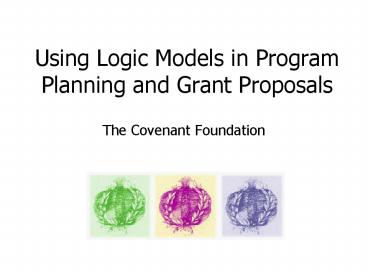Using Logic Models in Program Planning and Grant Proposals PowerPoint PPT Presentation
1 / 17
Title: Using Logic Models in Program Planning and Grant Proposals
1
Using Logic Models in Program Planning and Grant
Proposals
- The Covenant Foundation
2
Goals of this Presentation
- Introduce the concept of a logic model and show
its use in program planning and grant proposals - Describe the components of a well-designed
program plan - Present a model that is aligned with Covenant
Foundation grant proposals
3
What is a Logic Model?
- A logic model...
- is a simplified picture of a program, initiative,
or intervention - shows the logical relationships among the
resources that are invested, the activities that
take place, and the benefits or changes that
result - is the core of program planning, evaluation,
program management and communications
4
Why Use a Logic Model?
- A logic model can
- Make underlying beliefs explicit
- Build understanding and promote consensus about
what a program is and how it will work - Bring detail to broad goals
- Help to identify gaps in program logic and
clarify assumptions so success is more likely - Summarize complex programs to communicate with
stakeholders, funders, and other audiences
5
Basic Logic Model
Program Design
Measurable Changes In Awareness Knowledge Atti
tudes Skills Opinions Aspirations Motivations Beha
viors Practice Decision making
Evidence of Service Delivery Number
of programs Participation rates Hours
of services Amount of materials distributed
How Resources Are Used Deliver
services Conduct classes/ workshops Develop curri
cula/ materials
Resources Invested Time Staff Volunteers Mone
y Facilities Supplies Technology Partners Networks
Other Models
Planned Work
Intended Results
6
Planned Work Inputs
Outputs
Outcomes (Short and Long Term)
Inputs
Activities
- Inputs the resources and contributions that go
into the project, including - staff and volunteers
- time
- facilities
- supplies
- funding
- existing organizations
- potential collaborating partners
- existing organizational or interpersonal networks
7
Planned Work Activities
Outputs
Outcomes (Short and Long Term)
Inputs
Activities
- Activities the processes, events, and actions of
the program, including - services
- classes
- events
- training
- counseling
- materials development
- curricula
- other educational materials
8
Intended Results Outputs
Outputs
Outcomes (Short and Long Term)
Inputs
Activities
- Outputs the direct results of program
activities, including - number of classes taught, or workshops or
meetings held - program participation rates
- hours of services provided
- amount of materials produced and distributed
9
Intended Results Outcomes
Outputs
Outcomes (Short and Long Term)
Inputs
Activities
- Outcomes the resulting benefits for individuals,
families, groups, or communities, such as changes
in - skills
- knowledge
- behavior
- motivations
- satisfaction levels
- Outcomes should be SMART Specific, Measurable,
Achievable, Results-oriented, Timed
10
Program Theory
- The Statement of Need A clear succinct statement
that describes the situation or challenge to be
addressed the cause of the situation and those
effected by it. - Context The factors in the external environment,
both barriers and supports, that will impact your
ability to address the targeted need in your
institution/community. - Assumptions Beliefs about the need or situation
the behavior, motivations, and learning styles of
the target population the external and internal
environments and what the program can reasonably
achieve. Assumptions explain why you believe
your program will succeed. - Other Models Approaches to addressing the need
that have been tried by you or others, and whose
successes and/or failures you are now drawing
upon for your planning.
11
Using Logic Models in Program Planning Plan
Backwards, Implement Forward
Outputs
Inputs
Activities
Outcomes
What are our ultimate goals? Based on your
work What changes do we hope to see in
individuals? families? the community?...
What level and amount of services/ activities wil
l we need to provide to achieve these outcomes?
What activities will you need to engage in to
provide these services/ activities?
What resources will you need to engage in
these activities at the level and amount
required to achieve your outcomes?
12
Sources and Resources
- W. K. Kellogg Foundation
- Logic Model Development Guide http//www.wkkf.org/
Pubs/Tools/Evaluation/Pub3669.pdf - The University of Wisconsin
- Enhancing Program Performance with Logic Models
(web-based course) http//www.uwex.edu/ces/lmcour
se/ - National Science Foundation
- On-Line Evaluation Resources Library
http//oerl.sri.com/index.html
13
Covenant Foundation Full Proposal Budget
14
Using the Budget Template
- Expenses
- Personnel, Supplies, Other
- Project Budget and Request to Foundation
- Revenue
- In-Kind
- Other Grants
- Program Fees
- Other (i.e. individual contributions)
- Simply enter numbers.
- Formulas are already set.
15
Budget Guidelines
- Personnel
- Focus on expenses directly related to the
proposed program - No overhead
16
Financial Statement Form
- Revenue
- Contributions
- Fees and Dues
- Grants
- Earned Income
- Other
- Expenses
- Personnel
- Professional Fees
- Occupancy Costs/Rent
- Travel and Meetings
- Supplies and Equipment
- Communications
- Other
- Other non-recurring expenses (i.e. capital
expense)
This form corresponds to the most recent
completed fiscal year.
17
Audited Financial Statements
- Preferred Copy of the most recent audited
financial statements. - If audited financials are not available, then
submit a copy of the most recent unaudited
financial statements. - If neither are available, please contact a
Foundation staff member who can discuss special
circumstances, including - New Organizations
- Fiscal Sponsors
- Etc.

